|
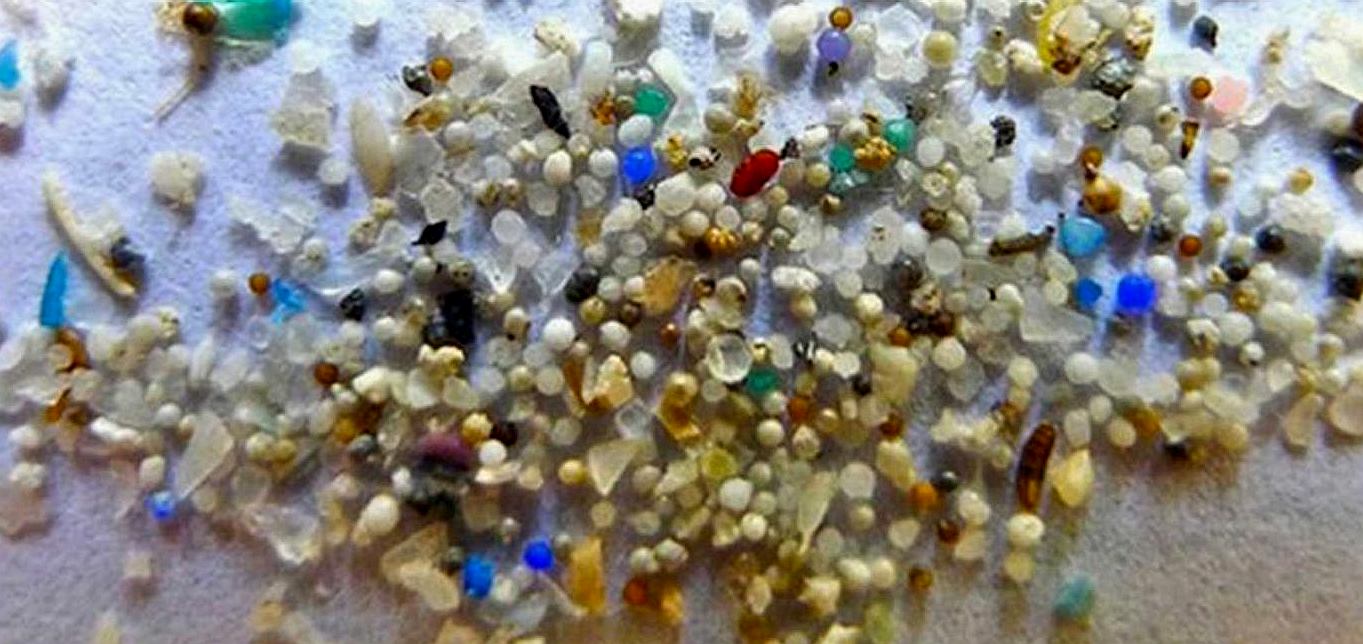
INDEPENDENT
JULY 2014 - Pollution of the oceans by tiny pieces of plastic debris is now so widespread that only radical action to eliminate the waste at source can limit further damage to marine wildlife, according to scientists.
Microplastics, which can range in size from being invisible to the naked eye to just a few millimetres in diameter, are now turning up in all the world's major oceans including the
Arctic and Antarctic, and it is no longer feasible to think it may be possible to simply "clear up the mess", researchers add.
Most people are aware of the visible plastic pollution such as discarded bottles and other waste items washed up on beaches, but it is the invisible plastics that are likely to pose the bigger risks to animals and plants, say marine scientists Karen Lavender Law and Richard Thompson. And they warn that the problems will only get worse unless drastic action is taken to curb the sale of disposable plastic products worldwide and dispel the idea that plastic waste can be just thrown away.
"Microplastics are likely the most numerically abundant items of plastic debris in the ocean today, and quantities will inevitably increase, in part because large, single plastic items ultimately degrade into millions of microplastic pieces," according to Lavender and Thompson's report in the journal Science.
"Given concerns over microplastics, the temptation may be to 'clean up the mess', but substantial removal of microplastic debris from the environment is not feasible. Identification and elimination of some of the major inputs of plastic waste is a more promising route, as is reduced consumption and the recognition of plastic waste as a [reusable] resource," the report says.
Microplastics are easily ingested by fish, mussels and other sea animals, and there is growing scientific evidence linking them to the passage of deadly, persistent chemicals through the environment, such as the pesticide DDT and toxic PCBs, making them more concentrated when they come into contact with marine life, the report warns.
Microplastics are small plastic particles in the environment. While there is some contention over their size, the U.S. National Oceanic & Atmospheric Administration classifies microplastics as less than 5 mm in diameter. They can come from a variety of sources, including cosmetics, clothing, and industrial processes.
Two classifications of microplastics currently exist: primary microplastics are manufactured and are a direct result of human material and product use, and secondary microplastics are microscopic plastic fragments derived from the breakdown of larger plastic debris like the macroscopic parts that make up the bulk of the Great Pacific Garbage Patch. Both types are recognized to persist in the environment at high levels, particularly in aquatic and marine ecosystems.
Because plastics do not break down for many years, they can be ingested and incorporated into and accumulated in the bodies and tissues of many
organisms. The entire cycle and movement of microplastics in the environment is not yet known, but research is currently underway to investigate this issue.
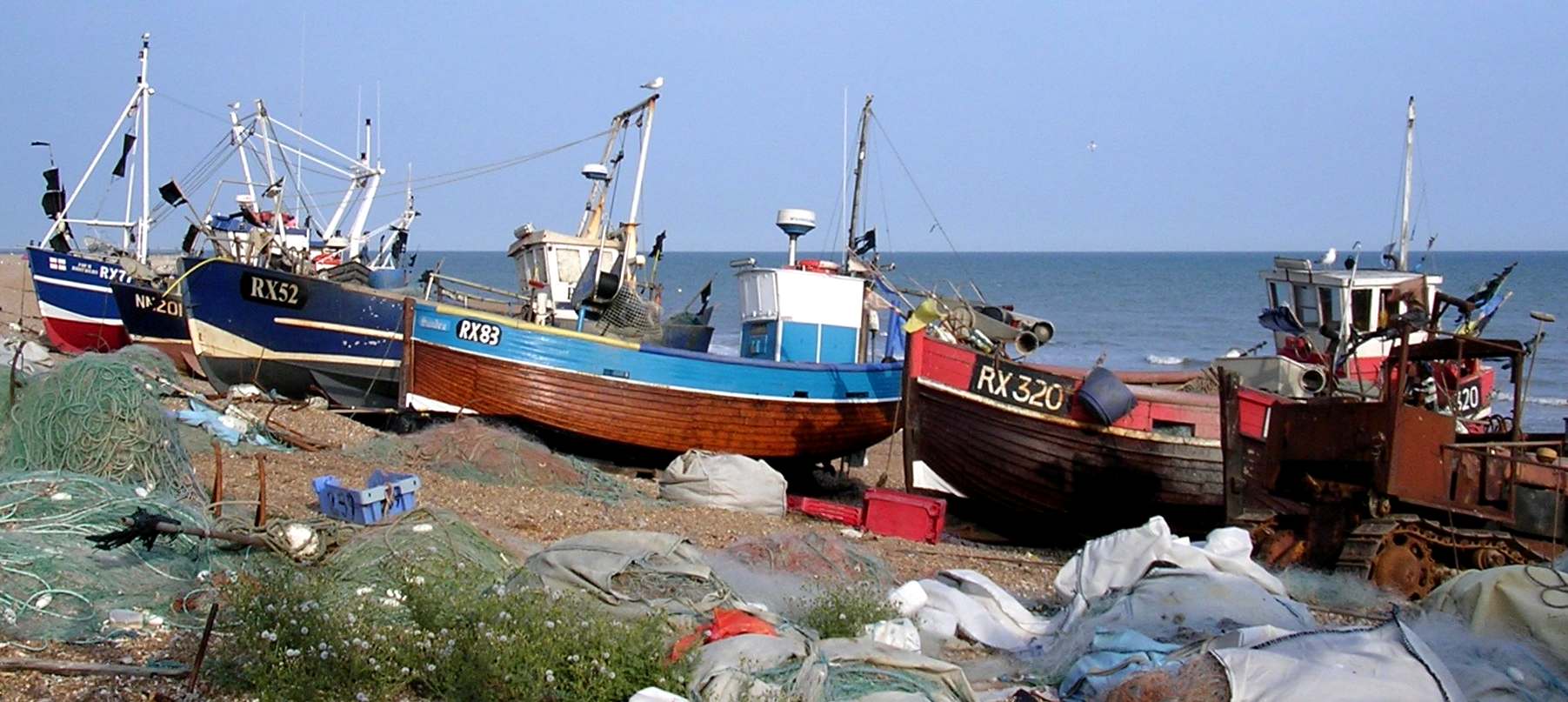
PLASTIC
& NETS - This fishing fleet at Hastings in England, litters the
beaches with plastic containers and nets, some of which will find their
way into the oceans and will kill marine life. Fibers and microbeads pervade our seas, coming from
clothing and cosmetics, and ending up in the stomachs of
larval fish, so
entering the food chain to eventually poison us.
WHERE
DOES IT COME FROM?
The existence of microplastics in the environment is often proved via aquatic-related studies. These include taking plankton samples, analyzing sandy and muddy sediments, observing vertebrate and invertebrate consumption, and evaluating chemical pollutant interactions. Through such methods, it has been recognized that there are a variety of microplastics in the environment from multiple sources.
Microplastics could contribute up to 30% of the ‘plastic soup’ polluting the world’s oceans and – in many developed countries – are a bigger source of marine plastic pollution than the more visible larger pieces of marine litter, according to a 2017 IUCN report.
Estimates of emissions of microplastics to the environment in Denmark are between 5,500 and 14,000 tonnes (6,100 and 15,400 tons) per year. Secondary microplastics (e.g. from tyres or footwear) are more important than primary microplastics by two orders of magnitude. The formation of microplastics from the degradation of larger plastics in the environment is not accounted for in the study.
Cosmetics industry
Some companies have replaced natural exfoliating ingredients with microplastics, usually in the form of "microbeads" or "micro-exfoliates". These products are typically composed of polyethylene, a common component of plastics, but they can also be manufactured from polypropylene, polyethylene terephthalate, and nylon. They are often found in face washes, hand soaps, and other such personal care products, so the beads are usually washed into the sewage system immediately after use. Their small size prevents them from being retained by preliminary treatment screens at wastewater plants, thereby allowing them to enter rivers and oceans.
Clothing
Studies have shown that many synthetic fibers, like nylon and acrylics, can be shed from clothing and persist in the
environment. One load of laundry can contain more than 1,900 fibers of microplastics, with fleeces releasing the highest percentage of fibers. Washing machine manufacturers have also reviewed research into whether washing machine filters can reduce the amount of microfiber fibers that need to be treated by water treatment facilities.
Manufactured goods
The manufacture of plastic products uses granules and small resin pellets as their raw material. In the United States, production increased from 2.9 million pellets in 1960 to 21.7 million pellets in 1987. Through accidental spillage during land or sea transport, inappropriate use as packing materials, and direct outflow from processing plants, these raw materials can enter aquatic ecosystems. In an assessment of Swedish waters using an 80 µm mesh, KIMO Sweden found typical microplastic concentrations of 150–2,400 microplastics per m3; in a harbor adjacent to a plastic production facility, the concentration was 102,000 per m3.
Coastal tourism
Recreational and commercial fishing, marine vessels, and marine industries are all sources of plastic that can directly enter the marine environment, posing a risk to biota both as macroplastics, and as secondary microplastics following long-term degradation. Tourism and recreational activities account for an array of plastics being discarded along beaches and coastal resorts. Marine debris observed on beaches also arises from beaching of materials carried on in-shore and ocean currents. Fishing gear is one of the most commonly noted plastic debris items with a marine source. Discarded or lost fishing gear, including plastic monofilament line and nylon netting, is typically neutrally buoyant and can therefore drift at variable depths within the oceans.
Shipping
Shipping has significantly contributed to marine pollution. Some statistics indicate that in 1970, commercial fishing fleets around the world threw over 23,000 tons of plastic waste into the marine environment. In 1988, an international agreement (MARPOL 73/78, Annex V) was implemented and prohibited the dumping of waste from ships into the marine environment. However, due to non-implementation of the agreement, shipping remains a dominant source of plastic pollution, having contributed around 6.5 million tons of plastic in the early 1990s.
Natural calamities
Floods or hurricanes can accelerate transportation of waste from land to the marine environment. A Californian study revealed that after a storm, the transport of plastics increased from 10 to 60 microplastics per m3. The study showed how the waste was transported and deposited at much greater distances from the river mouth than usual. A similar study conducted near the southern coast of California showed an increase of microplastics from 1 to 18 pieces per m3 after a storm. The abundance and global distribution of microplastics in the oceans has steadily increased over the last few decades with rising plastic consumption worldwide.
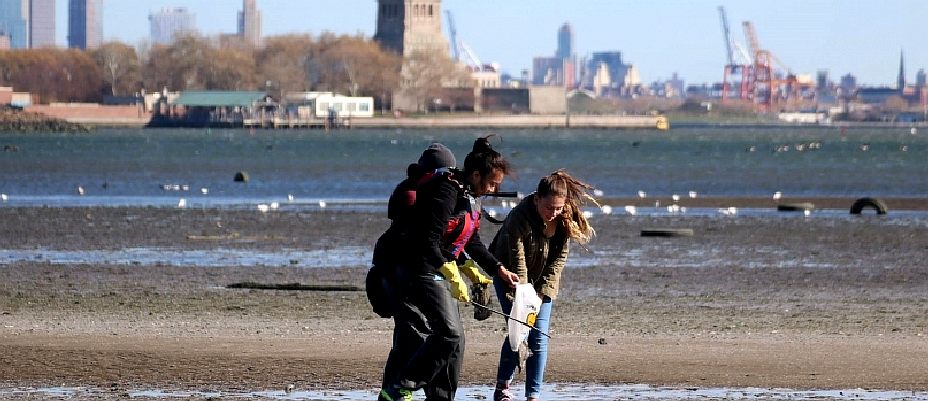
POLICIES -
With increasing knowledge of the detrimental effects of microplastics on the environment, many groups are now advocating for the removal and ban of microplastics from various products. One of the most prominent campaigns is the "Beat the Microbead" movement, which focuses on removing plastics from personal care products. The Adventurers and Scientists for Conservation are running a Microplastics Project that is working to pass a national ban on microbeads in household items and cosmetics. Even UNESCO has sponsored research and global assessment programs due to the trans-boundary issue that microplastic pollution constitutes. These environmental groups will seemingly keep pressuring companies to remove plastics from their products in order to maintain healthy ecosystems. Statewide action has also been taken to mitigate the negative environmental effects of microplastics as Illinois was the first U.S. state to ban cosmetics containing microplastics. New Jersey Congressman Frank Pallone proposed the Microbead-Free Waters Act of 2014, which calls for a nationwide ban on the creation and sale of products that contain microbeads by 2018. The Microbead-Free Waters Act of 2015 was enacted after being signed by the President on December 28, 2015. It is effective from July 1, 2017 with respect to manufacturing, and July 1, 2018 with respect to introduction or delivery for introduction into interstate commerce
CLASSIFICATION
Primary microplastics
These are particles of plastics that are purposefully manufactured to be
microscopic. They are usually used in facial cleansers and cosmetics, or
in air blasting technology. In some cases, their use in medicine as
vectors for drugs was reported. Microplastic "scrubbers", used
in exfoliating hand cleansers and facial scrubs, have replaced
traditionally used natural ingredients, including ground almonds, oatmeal
and pumice. Primary microplastics have also been produced for use in air
blasting technology. This process involves blasting acrylic, melamine or
polyester microplastic scrubbers at machinery, engines and boat hulls to
remove rust and paint. As these scrubbers are used repeatedly until they
diminish in size and their cutting power is lost, they often become
contaminated with heavy metals such as cadmium, chromium, and lead.
Secondary microplastics
These are described as microscopic plastic fragments derived from the breakdown of larger plastic debris, both at sea and on land. Over time, a culmination of physical, biological and chemical processes can reduce the structural integrity of plastic debris, resulting in fragmentation. It is considered that microplastics might further degrade to be smaller in size, although the smallest microparticle reportedly detected in the oceans at present is 1.6 micrometres (6.3×10−5 in) in diameter. The prevalence of microplastics with uneven shapes suggests that fragmentation is a key source.
Other sources: as a by-product/dust emission during wear and tear
Examples of these include dust from synthetic textiles, ropes, paint and waste treatment. These sources of microplastics are quite recently recognized and are somewhere between primary and secondary
microplastics. A Norwegian Environment Agency review report about microplastics published in early 2015 states it would be beneficial to classify these sources as primary, as long as microplastics from these sources are added from human society at the "start of the pipe", and their emissions are inherently a result of
human material and product use and not secondary defragmentation in nature.
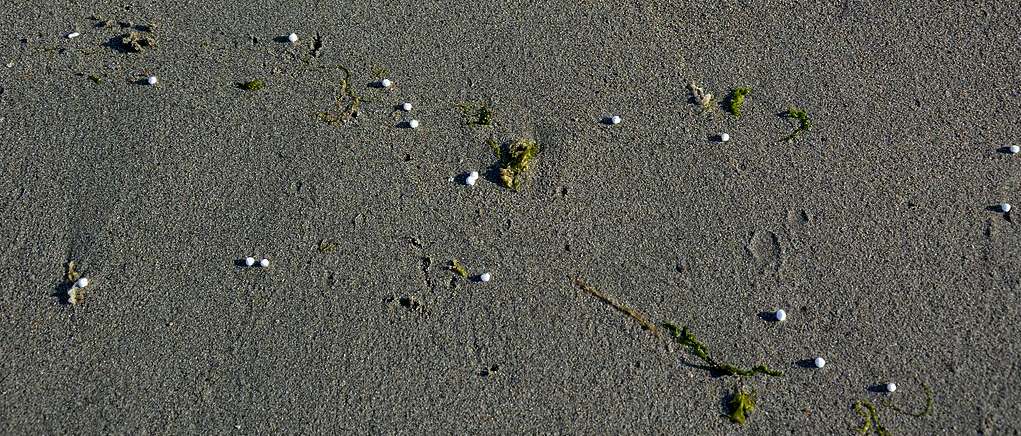
IRELAND
POLYSTYRENE BEADS
- Professor Thompson, a marine biologist at Plymouth University, first coined the term "microplastics" in 2004. It includes larger plastic items that have been degraded down in size as well as tiny plastic "micro-beads" used to exfoliate skin in soaps, creams and other products, which are deliberately designed to be washed down the drain.
"We know that a range of organisms will eat these microplastics and the prevalence in populations of some species may reach 80 per cent," he said. "Microplastic beads may also lead to the transfer of chemical contaminants into the animals that ingest the plastic. This is in addition to the physical damage done by the plastic itself."
Professor Law, a marine biologist at the Sea Education Association in Woods Hole, Massachusetts, was one of the first to describe the widespread plastic contamination in the North Atlantic Ocean from data gathered over more than 25 years. She said: "Our scientific understanding of this environmental problem is accelerating rapidly, with many new research efforts that go well beyond simply documenting the presence of plastic in the ocean."
The problem is not insurmountable, Professor Thompson said, as long as people are aware of how important it is to limit the amount of plastic waste that is needlessly thrown away. "We all use plastics every day, so whether it's a plastic bag we choose not to take home from the supermarket or a bottle that we recycle, ultimately it will be the collective actions of the many that will make the difference," he added.
The Marine Conservation Society said recent figures show the amount of plastic waste on British beaches – from plastic bottles and carrier bags to condoms and nappies – is now higher than at any time over the past 20 years. The charity hopes to recruit 10,000 volunteers this summer to help clear the waste in a mass-participation "Great British Beach Clean".
A survey by the society last year found an average of 2,309 pieces of litter for every kilometre of coastline – a 10-year record, it said.
ENVIRONMENTAL
IMPACT
The first International Research Workshop on the Occurrence, Effects and Fate of Microplastic Marine Debris at the University of Washington Tacoma campus in Tacoma,
Washington, USA, from September 9–11, 2008, agreed that microplastics may pose problems in the marine environment, based on the following:
* the documented occurrence of microplastics in the marine
environment
* the long residence times of these particles (and, therefore, their likely buildup in the future), and
* their demonstrated ingestion by marine organisms.
So far, research has mainly focused on larger plastic items. Widely recognized problems are associated with entanglement, ingestion, suffocation and general debilitation often leading to death and/or strandings. This raises serious public concern. In contrast, microplastics are not as conspicuous, being less than 5 mm. Particles of this size are available to a much broader range of species and therefore can cause serious threats.
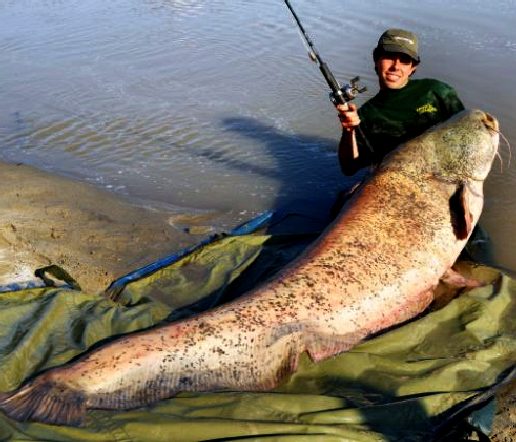
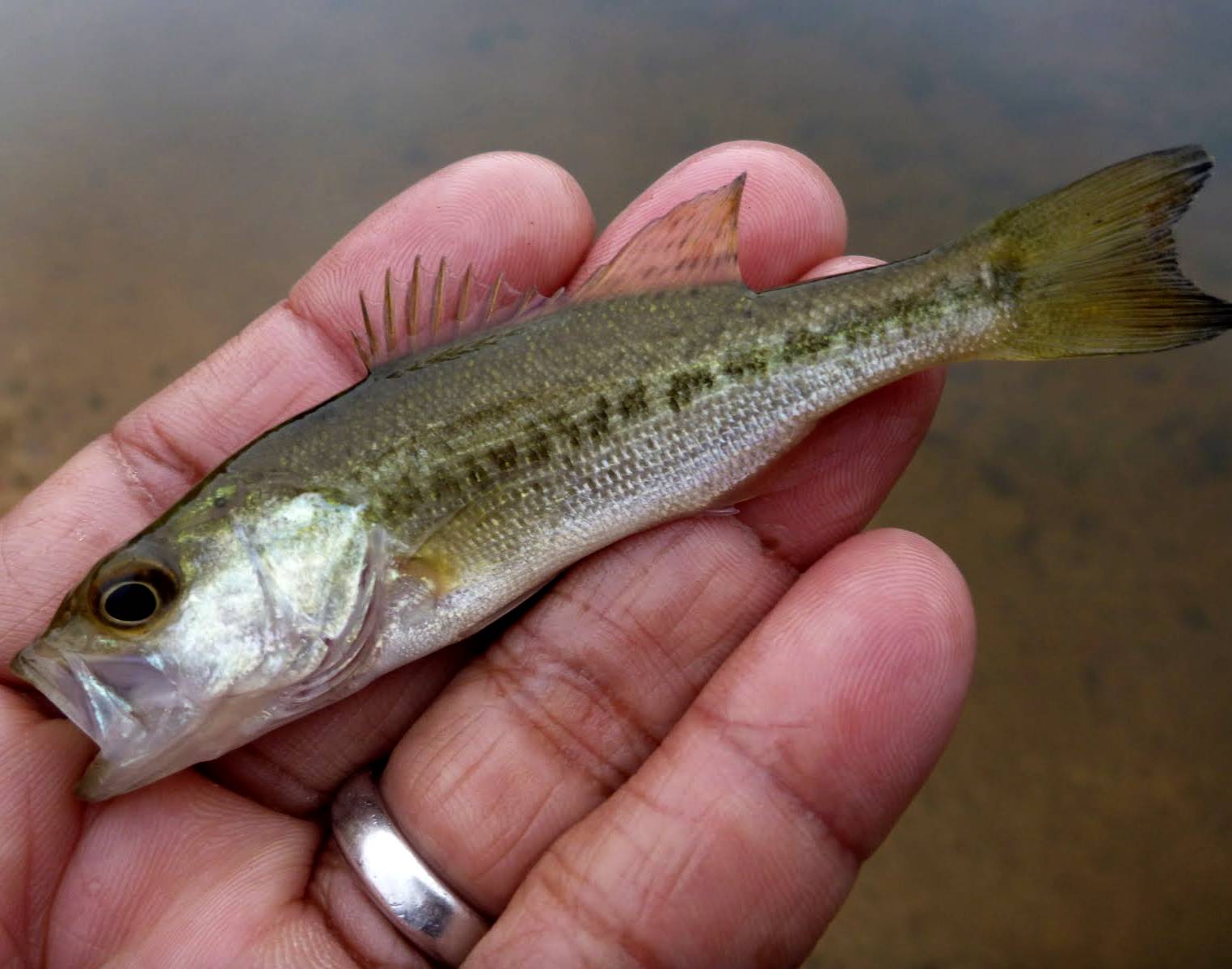
DAILY
MAIL - [LEFT] This monster from the deep has broken the record for the biggest freshwater fish caught in Europe.
Measuring 8.2ft long and weighing just over 250lbs the gigantic catfish was heaved out of a lake after a 45 minute back-breaking tussle.
Plucky angler Roberto Godi was nearly thrown into the water when the brute took his bait of a bream fish.
Not only is the catch the biggest of its kind in Europe, it is also the biggest species of wels catfish ever caught in the world.
[RIGHT] If our plastic problem is not tackled we might end up with smaller
fish and less of them.
Biological integration into organisms
Microplastics often become embedded in animals' tissue through ingestion or respiration. Various annelid species, such as deposit-feeding lugworms (Arenicola marina), have been shown to have microplastics embedded in their gastrointestinal tracts. Many crustaceans, like the shore crab Carcinus maenas have been seen to integrate microplastics into both their respiratory and digestive tracts.
Additionally, bottom feeders like benthic sea cucumbers, who are non-selective scavengers that feed on debris on the ocean floor, ingest large amounts of sediment. It has been shown that four species of sea cucumber (Thyonella gemmate, Holothuria floridana, H. grisea and Cucumaria frondosa) ingested between 2- and 20-fold more PVC fragments and between 2- and 138-fold more nylon line fragments (as much as 517 fibers per organism) based on plastic to sand grain ratios from each sediment treatment. These results suggest that individuals may be selectively ingesting plastic particles. Since this suggestion opposes the previously determined indiscriminate feeding strategy of sea cucumbers, this trend may be something which could potentially occur in all non-selective feeders when presented with microplastics.
Not only fish and free-living organisms can ingest microplastics. Scleractinian
corals, which are primary reef-builders, have been shown to ingest microplastics under laboratory conditions. While the effects of ingestion on these corals has not been studied, corals can easily become stressed and bleach. It was also noted that microplastics were present stuck to the exterior of the corals after exposure in the laboratory. The adherence to the outside of corals can potentially be harmful, because corals cannot handle sediment or any particulate matter on their exterior and slough it off by secreting mucus, and they expend a large amount of energy in the process, increasing the chances of mortality.
It was found that zooplankton ingest microplastics beads (1.7–30.6 μm) and excrete fecal matter contaminated with microplastics. Along with ingestion, the microplastics stick to the appendages and exoskeleton of the
zooplankton. Zooplankton, among other marine organisms, consume microplastics because they emit similar infochemicals, notably dimethyl sulfide, as phytoplankton and other organic materials. Plastics such as high-density polyethylene (HDPE), low-density polyethylene (LDPE), and polypropylene (PP) produce dimethyl sulfide odors. These types of plastics are commonly found in plastic bags, bleach, food storage containers, and
bottle
caps.
It can take at least 14 days for microplastics to pass from an animal (as compared to a normal digestion periods of 2 days), but enmeshment of the particles in animals' gills can cause a prolonged presence. When microplastic-laden animals are consumed by predators, the microplastics are then incorporated into the bodies of higher trophic-level feeders. For example, scientists have reported plastic accumulation in the stomachs of lantern fish which are small filter feeders and are the main prey for commercial fish like
tuna and swordfish. Microplastics also absorb chemical pollutants that can be transferred into the organism's tissues. Furthermore, small animals are at risk of reduced food intake due to false satiation and resulting starvation or other physical harm from the microplastics.
Humans
As fish is the primary source of protein for nearly one-fifth of the human population, it is important to consider that the microplastics ingested by fish and crustaceans can be subsequently consumed by humans as the end of the food chain. In a study done by the State University of
New York, 18 fish species were sampled and all species showed some level of plastics in their systems. Many additional researchers have found evidence that these fibers had become chemically-associated with metals, polychlorinated biphenyls, and other toxic contaminants while in water. The microplastic-metal complex can then enter humans via consumption. It remains unclear how much of an impact this has directly on the health of humans, but research on this issue continues.
As a dispersal of biota
Plastic debris has also been shown to serve as carrier for the dispersal of biota, thus greatly increasing dispersal opportunities in the oceans, endangering marine biodiversity worldwide. The dispersal of aggressive alien and invasive species is as much a topic as the dispersal of cosmopolitan species. By spreading species to regions that they normally do not inhabit, disruptions in local ecosystems can occur. The fact that microplastics can negatively perpetuate the dispersal of biota is notable, especially when policies and laws are being implemented about the usage of plastic.
Effects on buoyancy
Approximately half of the plastic material introduced to the marine environment is buoyant, but fouling by organisms can induce the sinking of additional plastic debris to the sea floor, where it may interfere with sediment-dwelling species and sedimental gas exchange processes. Buoyancy changes in relation to ingestion of microplastics have been clearly observed in autotrophs because the absorption can interfere with photosynthesis and subsequent gas levels. However, this issue is of more importance for larger plastic debris.
Persistent Organic Pollutants (POPs)
Furthermore, plastic particles may highly concentrate and transport synthetic organic compounds (e.g. persistent organic
pollutants), commonly present in the environment and ambient sea water, on their surface through adsorption. It still remains unknown if microplastics can act as agents for the transfer of POPs from the environment to organisms in this way, but evidence suggest this to be a potential portal for entering food webs. Of further concern, additives added to plastics during manufacture may leach out upon ingestion, potentially causing serious harm to the organism. Endocrine disruption by plastic additives may affect the reproductive health of humans and wildlife alike.
At current levels, microplastics are unlikely to be an important global geochemical reservoir for POPs such as PCBs, dioxins, and DDT in open oceans. It is not clear, however, if microplastics play a larger role as chemical reservoirs on smaller scales. A reservoir function is conceivable in densely populated and polluted areas, such as bights of mega-cities, areas of intensive agriculture and effluents flumes.
Plastics, polymers derived from mineral oils, are virtually non-biodegradable. However, renewable natural polymers are now in development which can be used for the production of biodegradable materials similar to that of oil-based polymers. Their properties in the environment, however, require detailed scrutiny before their wide use is propagated.

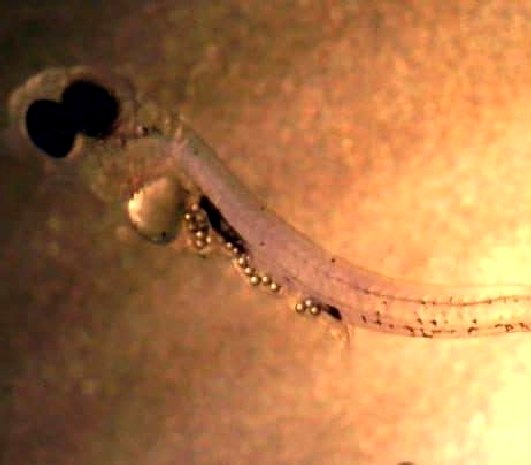
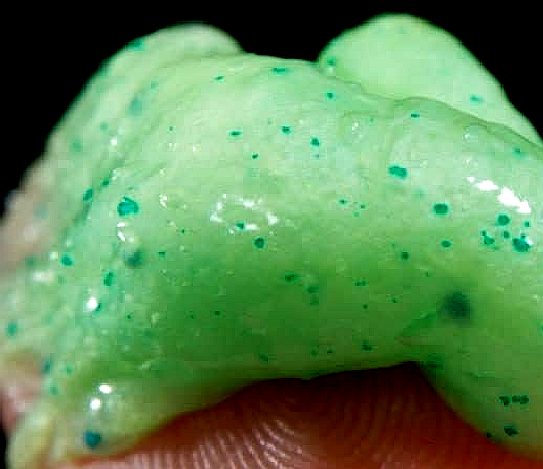
TELEGRAPH 3 June 2016
- The oceans' fish are becoming smaller because of the damaging effects of plastic waste in the water, scientists say.
A study of European perch larvae found for the first time that exposure to high concentrations of microplastics stunts growth and alters their feeding habits, leading them to only eat plastic and ignore their natural food source of free swimming zooplankton.
Experiments found the microplastic particles caused 15 percent fewer hatchings. What is more, two week old larvae were much less able to escape predation, leading to reduced survival.
Also, fish reared in the highest concentrations of plastics were significantly smaller than those that developed in average ones.
If this response in fish larvae translates to higher mortality rates as a result of increased predation risk in nature, there could be direct consequences for the sustainability of fish stocks.
Ecologist Professor Peter Eklov said: "Increases in microplastic pollution in the Baltic Sea and marked recruitment declines of the coastal keystone species, like perch and pike, have recently been observed.
"Our study suggests a potential driver for the observed decreased recruitment rate and increased mortality."
It has been estimated that by 2050 there will be more plastic in the sea than fish.
Marine biologist Dr Oona Lonnstedt added: "If early life history stages of other species are similarly affected by
microplastics, and this translates to increased mortality rates, the effects on aquatic ecosystems could be profound."
The latest results, published in Science, suggest the particles effect the performance and growth of larval fish both chemically and physically.
Plastics reach the oceans via waterways and lakes and build up in high concentrations in shallow coastal areas.
Much of this debris is microplastics, fragments less than five millimeters in all dimensions that are either manufactured that way, such as microbeads in personal care products, or break down from larger pieces of debris.
For the first time, scientists have now been able to show development of fish is threatened by microplastic pollution. While hundreds of studies have demonstrated global microplastic contamination, few have investigated its impacts on animal populations, communities, and ecosystems.
Dr Lonnstedt said: "Fish reared in different concentrations of microplastic particles have reduced hatching rates and display abnormal
behaviours.
"The microplastic particle levels tested in the current study are similar to what is found in many coastal habitats in Sweden and elsewhere in the world today."
The researchers at Uppsala University, Sweden, collected European perch embryos and larvae from the Baltic Sea. In lab aquariums they exposed these specimens to varying concentrations of polystyrene
microplastics, including very high concentrations comparable to those found in nature.
Prof Eklov said: "This is the first time an animal has been found to preferentially feed on plastic particles and is cause for concern."
Dr Lonnstedt said: "Larvae exposed to microplastic particles during development also displayed changed behaviours and were much less active than fish that had been reared in water that contained no microplastic particles.
"Furthermore, fish exposed to microplastic particles ignored the smell of predators which usually evoke innate anti predator behaviours in naďve fish."
This made larvae more vulnerable. Indeed, when perch were placed together with a pike, a natural predator, fish that had been exposed to microplastic particles were caught and eaten more than four times quicker than controls. All the fish exposed to microplastic particles were dead within 48 hours.
Dr Chelsea Rochman, an expert of the impact of plastic debris in fish, reviewed the findings for the journal and said "the pattern is not unique."
She said: "For many chemical contaminants in the environment, widespread contamination is documented, yet little is known about their ecological impacts."
The mechanisms by which microplastics impact eggs, embryos and larvae of aquatic organisms, which are particularly vulnerable to water borne pollutants, are especially murky.
The researchers said studies like this could guide efforts to mitigate the entry of microplastics into the oceans by determining the types that may be most hazardous and by identifying the most sensitive populations, species and ecosystems.
Dr Rochman, of the University of California, Davis, added: "With such data in hand, practitioners can shift their energy toward prevention and avoid the need for costly recovery and restoration."

LINKS
& REFERENCE
http://www.telegraph.co.uk/news/2016/06/02/dangerous-microplastics-in-oceans-stunt-the-growth-of-fish/ http://www.independent.co.uk/news/science/microplastic-waste-this-massive-tiny-threat-to-sea-life-is-now-in-every-ocean-9602430.html https://en.wikipedia.org/wiki/Microplastics http://www.pelletwatch.org/ https://marinedebris.noaa.gov/
|








